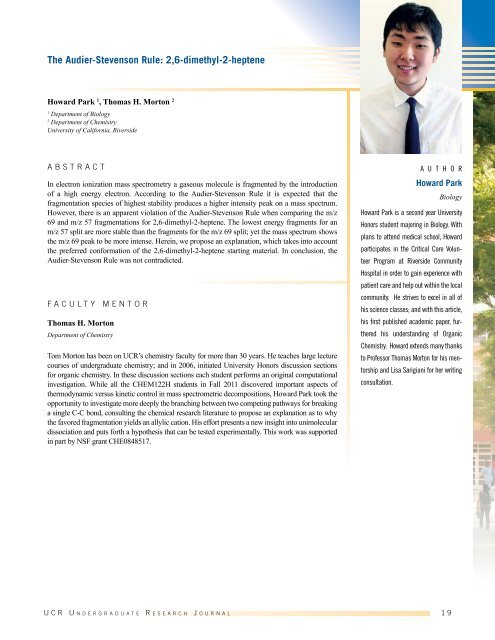Undergraduate Research Journal
Undergraduate Research Journal
Undergraduate Research Journal
You also want an ePaper? Increase the reach of your titles
YUMPU automatically turns print PDFs into web optimized ePapers that Google loves.
The Audier-Stevenson Rule: 2,6-dimethyl-2-heptene<br />
Howard Park 1 , Thomas H. Morton 2<br />
1<br />
Department of Biology<br />
2<br />
Department of Chemistry<br />
University of California, Riverside<br />
ABSTRACT<br />
In electron ionization mass spectrometry a gaseous molecule is fragmented by the introduction<br />
of a high energy electron. According to the Audier-Stevenson Rule it is expected that the<br />
fragmentation species of highest stability produces a higher intensity peak on a mass spectrum.<br />
However, there is an apparent violation of the Audier-Stevenson Rule when comparing the m/z<br />
69 and m/z 57 fragmentations for 2,6-dimethyl-2-heptene. The lowest energy fragments for an<br />
m/z 57 split are more stable than the fragments for the m/z 69 split; yet the mass spectrum shows<br />
the m/z 69 peak to be more intense. Herein, we propose an explanation, which takes into account<br />
the preferred conformation of the 2,6-dimethyl-2-heptene starting material. In conclusion, the<br />
Audier-Stevenson Rule was not contradicted.<br />
FACULTY Mentor<br />
Thomas H. Morton<br />
Department of Chemistry<br />
Tom Morton has been on UCR’s chemistry faculty for more than 30 years. He teaches large lecture<br />
courses of undergraduate chemistry; and in 2006, initiated University Honors discussion sections<br />
for organic chemistry. In these discussion sections each student performs an original computational<br />
investigation. While all the CHEM122H students in Fall 2011 discovered important aspects of<br />
thermodynamic versus kinetic control in mass spectrometric decompositions, Howard Park took the<br />
opportunity to investigate more deeply the branching between two competing pathways for breaking<br />
a single C-C bond, consulting the chemical research literature to propose an explanation as to why<br />
the favored fragmentation yields an allylic cation. His effort presents a new insight into unimolecular<br />
dissociation and puts forth a hypothesis that can be tested experimentally. This work was supported<br />
in part by NSF grant CHE0848517.<br />
A U T H O R<br />
Howard Park<br />
Biology<br />
Howard Park is a second year University<br />
Honors student majoring in Biology. With<br />
plans to attend medical school, Howard<br />
participates in the Critical Care Volunteer<br />
Program at Riverside Community<br />
Hospital in order to gain experience with<br />
patient care and help out within the local<br />
community. He strives to excel in all of<br />
his science classes; and with this article,<br />
his first published academic paper, furthered<br />
his understanding of Organic<br />
Chemistry. Howard extends many thanks<br />
to Professor Thomas Morton for his mentorship<br />
and Lisa Sarigiani for her writing<br />
consultation.<br />
U C R U n d e r g r a d u a t e R e s e a r c h J o u r n a l 1 9














